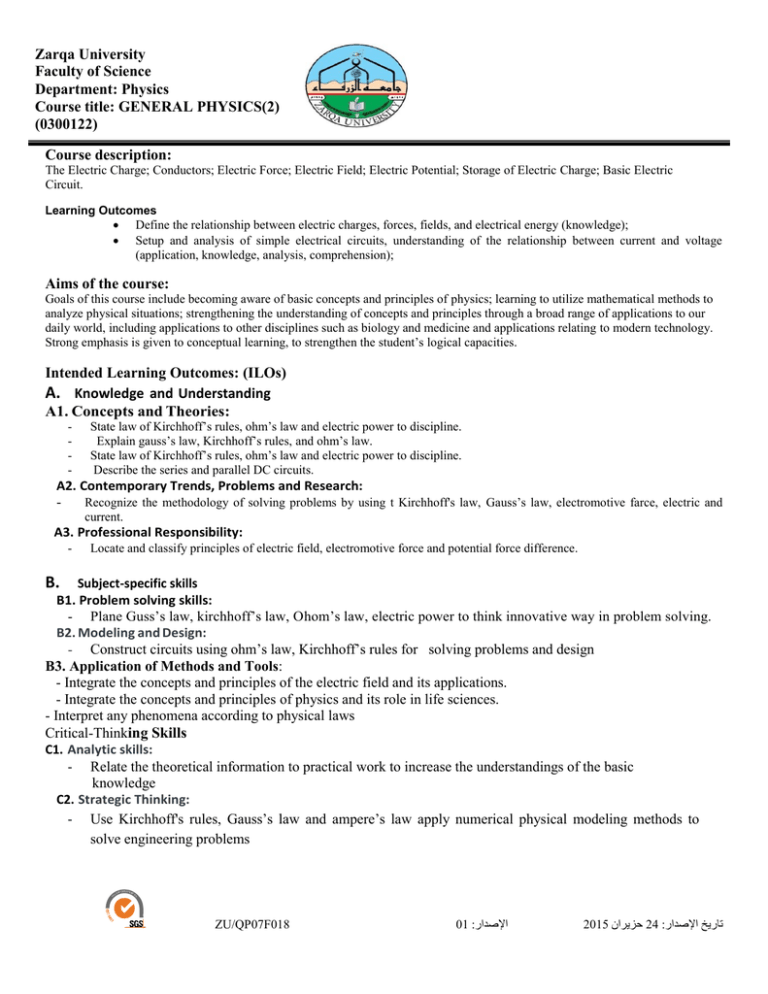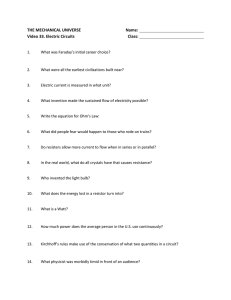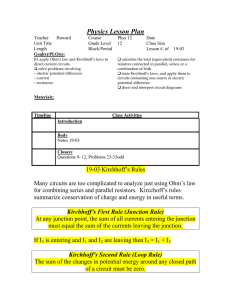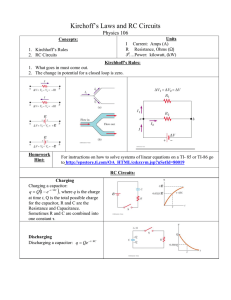Course description
advertisement

Zarqa University Faculty of Science Department: Physics Course title: GENERAL PHYSICS(2) (0300122) Course description: The Electric Charge; Conductors; Electric Force; Electric Field; Electric Potential; Storage of Electric Charge; Basic Electric Circuit. Learning Outcomes Define the relationship between electric charges, forces, fields, and electrical energy (knowledge); Setup and analysis of simple electrical circuits, understanding of the relationship between current and voltage (application, knowledge, analysis, comprehension); Aims of the course: Goals of this course include becoming aware of basic concepts and principles of physics; learning to utilize mathematical methods to analyze physical situations; strengthening the understanding of concepts and principles through a broad range of applications to our daily world, including applications to other disciplines such as biology and medicine and applications relating to modern technology. Strong emphasis is given to conceptual learning, to strengthen the student’s logical capacities. Intended Learning Outcomes: (ILOs) A. Knowledge and Understanding A1. Concepts and Theories: - State law of Kirchhoff’s rules, ohm’s law and electric power to discipline. Explain gauss’s law, Kirchhoff’s rules, and ohm’s law. State law of Kirchhoff’s rules, ohm’s law and electric power to discipline. Describe the series and parallel DC circuits. A2. Contemporary Trends, Problems and Research: Recognize the methodology of solving problems by using t Kirchhoff's law, Gauss’s law, electromotive farce, electric and current. A3. Professional Responsibility: - Locate and classify principles of electric field, electromotive force and potential force difference. B. Subject-specific skills B1. Problem solving skills: - Plane Guss’s law, kirchhoff’s law, Ohom’s law, electric power to think innovative way in problem solving. B2. Modeling and Design: - Construct circuits using ohm’s law, Kirchhoff’s rules for solving problems and design B3. Application of Methods and Tools: - Integrate the concepts and principles of the electric field and its applications. - Integrate the concepts and principles of physics and its role in life sciences. - Interpret any phenomena according to physical laws Critical-Thinking Skills C1. Analytic skills: - Relate the theoretical information to practical work to increase the understandings of the basic knowledge C2. Strategic Thinking: - Use Kirchhoff's rules, Gauss’s law and ampere’s law apply numerical physical modeling methods to solve engineering problems ZU/QP07F018 01 :اإلصدار 2015 حزيران24 :تاريخ اإلصدار C3. Creative thinking and innovation: - Practice Kirchhoff's rules, series and parallel capacitors and resistance . C. General and Transferable Skills (other skills relevant to employability and personal development) D1. Communication: -Apply different physical principles in different disciplines of science and medicine. - Enhance the observation of individual to the natural phenomena. - Assist the student to participate in life science studies D2. Teamwork and Leadership: - Increase the cooperative behavior between the different research groups of different applications. - To work in stressful environment and within constraints. To Communicate effectively. Use the efficient IT capabilities. Management the tasks efficiently. To Acquire entrepreneurial skills. Refer to relevant literature effectively. Searching for the information and going to self learning a new topic Course structures: Credit Week ILOs Hours 1,2 3 3,4 3 5,6,7 3 8,9 3 10,11 3 12,13 3 Topics A1,A3,D1,C2 Teaching Procedure Assessment methods Class participation problems (5, 7, 15, 21, 33, 40, 44, 56) pages 730-737 A3,B3,C1,C2 Lecturing Gauss's Law Homework: text problems(4, 11, discussion 15, 17, 22, 24, 37, 55, 57)pages 755-76178 A3,C2,C3 Lecture, Class Oral, Homework: text Electric Potential discussion problems(9, 16, 19, 34, 39, 40, 43, 47)page 787-794 Short-answer questions A3,B1,B3,C2 Capacitance and Dielectrics LectureProblem sheets, Homework: text demonstration problems(7, 21, 25, 37, 61, 72 Problem solving or 75)page 822-830 case studies A1,C2,B3,A3 Lecturing Oral, Homework: text Current and Resistance discussion problems(3, 7, 15, 26, 41, 65)page 852-857 Short-answer questions A1,B1, LectureHomework: text problems(1, 5, Direct Current Circuits C2,B3,A3 demonstration 11, 15, 24, 30, 37)page 885-893 Problem solving Electric Fields Lecture, Oral inquiry References: A. Main Textbook: ZU/QP07F018 01 :اإلصدار 2015 حزيران24 :تاريخ اإلصدار ““Physics for Scientists and Engineers, R. A. Serway 6th edition B. Supplementary Textbook(s): 1. Fundamentals of Physics, David Halliday, Robert Resnick, and Jearal Walker. 2. University Physics, F.Sears, M. Zemansky, and H. Yaoung. 3. Principles of Physics, J.B Marion and W.F. Hornyak. Assessment Methods: Methods Grade st 1 2nd Final Date 25 25 50 ZU/QP07F018 01 :اإلصدار 2015 حزيران24 :تاريخ اإلصدار



